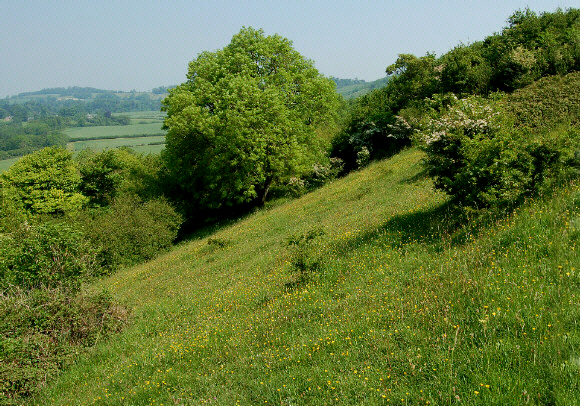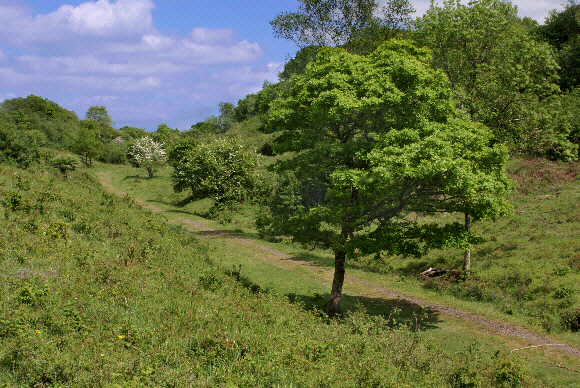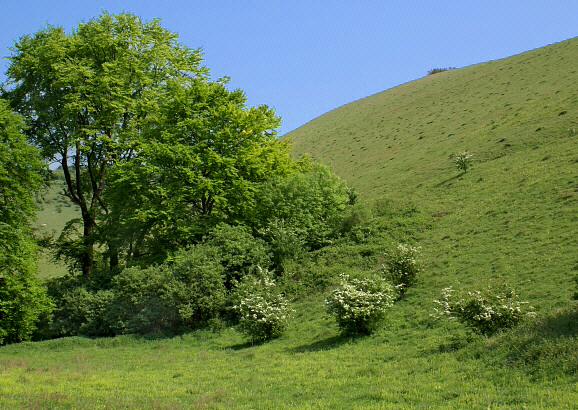Uncultivated grasslands are among the most important habitats for butterflies. If suitably managed they become carpeted in wild flowers such as birds foot trefoil, hairy violet, cowslip, horseshoe vetch, kidney vetch, common rockrose, devil’s bit scabious, sheep’s sorrel and creeping cinquefoil. Each of these plants serves as the larval foodplant of a particular species of butterfly.
These and many other wild flowers such as marjoram, thyme, knapweeds, self heal, germander speedwell, buttercup, dandelions and daisies are also extremely important as nectar sources for the adults.
Finally of course are the grasses – fescues, bents, couch, timothy, Yorkshire fog, wood false brome etc; which are the larval foodplants of various Skippers and Browns.

Chalk grassland at Cerne Abbas, Dorset, England – Adrian Hoskins
Extensive areas of calcareous ( chalk or limestone ) grassland such as the South Downs, North Downs, Chilterns, Malvern Hills, Purbeck Hills and Cotswolds can support enormous butterfly populations, but even small areas of grassland, in woodland clearings, along railway cuttings, in meadows and in abandoned chalk quarries are of immense value if suitably grazed and managed.

Disused railway line running through chalk grassland and woodland, Dorset – Adrian Hoskins
Grazing and scrub control
To ensure the continuing survival of a wide diversity of butterfly species, it is essential to manage grasslands so that they support a variety of different vegetation types.
Management has to be tailored according to the situation – some sites, because of their situation, can only be managed by mowing or flail cutting, but cattle or sheep grazing generally creates much better conditions for butterflies.
Sheep graze in a manner which produces a uniformly fine sward, with a profusion of vetches and trefoils, and creates a habitat particularly suitable for certain blues and skippers.
Cattle grazing, in conjunction with scrub control measures, has been shown to be the best overall management technique however, as the grazing pattern tends to create a mosaic of different sward heights, with a more diverse flora that accommodates a wider range of butterfly species.
The timing of grazing is extremely important – summer grazing can for example have a detrimental effect on species which spend summer in the larval stage, feeding on grasses or herbaceous plants.
Wild rabbits are of immense value as natural grazers, particularly as their excavations expose patches of bare soil where butterfly foodplants can germinate. Periodic surges in rabbit populations however can result in severe over-grazing that can easily wipe out certain butterfly species. Stock densities of cattle and sheep therefore need to be carefully tailored to take account of the effects of rabbit grazing in any particular year.
Another consideration is that each species of butterfly has different requirements – some need the grasses to be lush and tall, while others need it to be very short. The Adonis Blue and Silver-spotted Skipper for example will only breed at warm sites, favouring south facing slopes where the grass is short and sparse.
Chalkhill Blues, Small Coppers and most other grassland butterflies need a slightly taller sward of about 10cms, where the habitat is moister and rich in wild flowers. Most of the Satyrinae and Hesperiinae on the other hand require a sward of between 15 – 30cms.
Getting the balance right, to create a habitat that will support viable populations of a wide variety of species, can be very difficult particularly if the site is small. Unfortunately it is sometimes necessary to prioritise and cater for one particularly scarce species at the expense of another. On larger sites this is less of a problem because different parts of the site can be grazed at different times of year or at different livestock densities, to cater for a multitude of butterfly and moth species, while at the same time providing habitat for other forms of wildlife.
 Ramsdean Down, Hampshire – Adrian Hoskins
Ramsdean Down, Hampshire – Adrian Hoskins
It is not only the grasses and wild flowers that need to be managed – a site left unmanaged would within a few years become overgrown with bramble, privet, dogwood, buckthorn, gorse, hawthorn and blackthorn bushes which would shade out the herbaceous plants and grasses. Eventually the site would revert to woodland, and all the wild flowers and grassland butterflies would disappear.
Bushes therefore need to be periodically cut back – a process known colloquially as ‘scrub-bashing’. It’s very important however to get the balance right, because a certain amount of bushy vegetation is beneficial to butterflies, providing much needed shelter from wind and blazing sunlight. Bushes also provide perching places which males use as lookout posts from which to survey and intercept potential mates.
Excessive scrub removal can cause major problems for butterflies, because many species lay their eggs on herbaceous plants that grow around the base of bushes.
If they laid their eggs on plants in open areas away from bushes, the resulting caterpillars would perish – either through desiccation in bright sunlight, or because rabbits would eat the plants on which they depended ( plants growing close to bushes are normally ignored by rabbits ).Grassland butterflies thrive best, both in diversity and abundance, at sites where a well considered grazing and scrub control regime produces a mosaic habitat in which bare ground, short turf, lush vegetation and bushes are all essential elements.
